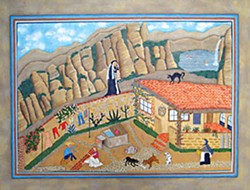[
{
"name": "Top Stories Video Pair",
"insertPoint": "7",
"component": "17087298",
"parentWrapperClass": "fdn-ads-inline-content-block",
"requiredCountToDisplay": "1"
}
]
It's a funny thing about education. Of course it's necessary, but when it gets too formalized, it can become limiting. A person who relies only on the education of institutions may gain a lot of knowledge, but will not gain wisdom. Wisdom comes from life experience -- hard knocks and intimate relationships, meeting other cultures, questioning one's own culture.
This reality accounts for the interest in "outsider art" and "naive art." These terms were coined in the last century, but the kind of art they refer to has really always existed. In fact, it was the "inside" which had to be created in order for there to be an "outside."
The terms are used loosely and are difficult to define. They are often interchanged, but shouldn't be, though there are similarities. Outsider art specifically refers to art created outside the bounds of cultural standards, and the most typical outsider artists are prisoners or patients of mental institutions. Naive art is that which either intentionally or unconsciously ignores the canons of perspective and proportion; in other words, visual accuracy. Naive art is commonly described as "childlike" or "simple."
As I said, these kinds of art were always around, but when art became institutionalized, when there was an "insider art," the insiders began to notice the outsiders and recognize something in them, some quality of innocent wisdom, that was attractive. For example, the French painter Henri Rousseau, known for the childlike quality of his work, may never have made it into the art history books if not for the almost joking interest of painters like Picasso and Delaunay. Reading about him, it's difficult to say if he was a fool or a genius. He is described as both. Perhaps they are two sides of the same coin.
Rousseau famously said that he had "no teacher other than nature." Lida Penkova also describes herself as "a self-taught artist," her education in art coming from her direct contact with a variety of cultures, her open mind and a lot of time spent looking at and discussing art. She writes, "It wasn't my dream or wish early on, to become a painter. What interested me most was to understand the human mind and behavior, and get to know other societies and cultures. So I became a psychologist, lived in different countries, always observing how people formed their everyday realities. Art interested me only as an observer -- I liked going to art museums, even more when I met my painter-husband. Seeing and discussing art became a daily reality."
After working for many years as a psychologist, she retired and felt the need for some creative outlet. In her words, "I needed to enter the world of imagination and leave behind the analytical way of seeing reality." At this point, all of the stories she had heard and people she had known came bubbling up into her intuitive paintings.
Myths and symbols are the driving force of Lida's work, although they are not a simple depiction of the stories. An example is her painting "La Llorona" (the Weeping Woman), which illustrates a common folk tale of Mexico (her home for many years) of a ghost woman who has drowned her children, but the piece also shows the painter's experience of how she came to know the story. In the painting, she sits in her garden, talking with her neighbor, Don Angel, who tells her the story and describes the times he has seen the ghost himself. The artist's aim is not simply to tell the story, but to tell it and all of the images and experiences they bring to mind at the time she is working on it.
The result for the viewer is a field as rich in stories and experiences as they are in color and texture. Each painting is accompanied by text that explains a bit about the artist's ideas, but it is just as satisfying to gaze at each painting and let one's own associations come to mind. There's so much to chew on in each painting that you will be captivated for awhile by the show.
Lida's decision to start painting in the middle of her life, with no formal training, was an inspiring act of courage. In a society that is so timid about making a move without the sanction of a degree or good grade point average, it's unusual for a person to decide that what they have to offer is worthwhile. But Lida has the wisdom of her experiences. "What is freedom really? It doesn't just come from outside," she explains. "You have to permit yourself." If you have dreams of traveling or painting or writing a novel, don't wait for tomorrow. "Tomorrow you can be dead, sorry to say. You don't know what to paint? Never mind! Take a piece of paper and stare at it and something will start looking back at you."
Aptly titled Narratives, Lida Penkova's show will be on exhibit at the Morris Graves Museum through Oct. 26. An Arts Alive! reception will be held Oct. 4, from 6-9 p.m. The museum is located at 636 F St. in Eureka; the hours are Wednesday through Sunday, noon to 5 p.m.
^^^^^
Send your art news (six weeks in advance) to [email protected] or write in care of the Journal at 145 South G Street, Suite A, Arcata, Calif., 95521.
more from the author
-
Obama and the Arts
Do we really need -- or want -- a Ministry of Culture?
- Feb 5, 2009
-
Humboldt Wild
By Arleen Olson. Self-published.
- Feb 5, 2009
-
Colors Flowing Like Water
Rande Rothman's silk paintings
- Jan 15, 2009
- More »
































